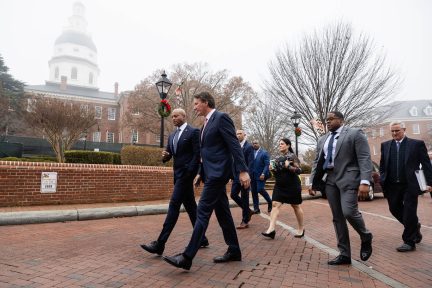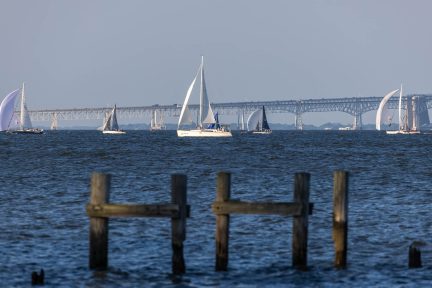New Course Charted for the Chesapeake Bay's Recovery
New Course Charted for the Chesapeake Bay's Recovery
The Chesapeake Executive Council today charted a new course for recovery of the Chesapeake Bay that will use short-term goals to dramatically accelerate the cleanup, increase government accountability and provide clean water in streams, creeks and rivers throughout the watershed. Restoration will also be greatly intensified by an Executive Order issued by President Barack Obama, who has declared the Chesapeake Bay a national treasure and deepened the federal commitment to restoring the estuary.
The new course for the restoration effort was announced at Historic Mount Vernon, Virginia, at the annual meeting of the Chesapeake Executive Council, which establishes the policy agenda for the Chesapeake Bay Program. Participating in the meeting were top executives from the U.S. Environmental Protection Agency; U.S. Department of Agriculture; the states of Maryland, Virginia, Pennsylvania, New York, Delaware, West Virginia; the District of Columbia; and the Chesapeake Bay Commission.
Instead of pursuing a distant deadline, the Chesapeake Bay Program will now focus on short-term goals every two years for reducing pollution, called milestones, with the first milestone on December 31, 2011. Many states will significantly increase the pace of cleanup. Watershed-wide, the rate of progress in reducing nitrogen will accelerate by 77 percent, for a projected reduction of 15.8 million pounds. The rate of progress in reducing phosphorus will increase by 79 percent, for a projected reduction of 1.1 million pounds. By meeting biennial milestones, all pollution control measures necessary for a restored Bay will be in place no later than 2025.
“We have charted a new course for the Chesapeake Bay’s recovery that will succeed because it includes the short-term goals necessary to make steady progress and is backed by federal and state leaders who share a profound conviction to protect our environment,” said Virginia Governor Timothy M. Kaine, chairman of the Executive Council. “It is our obligation to invest in clean water for communities today and future generations.”
President Obama’s Executive Order makes restoration of the Chesapeake Bay a greater national priority and contains many provisions, which include establishing a Bay federal leadership committee, directing EPA to fully use its Clean Water Act authorities, reducing water pollution from federal property, developing a Chesapeake Bay climate change strategy, improving agricultural conservation practices and expanding public access to the Bay.
Further federal action is coming from the U.S. Environmental Protection Agency, which is creating the Chesapeake Bay TMDL (Total Maximum Daily Load). The TMDL is essentially a pollution diet for the Bay that will drive the six states and D.C. to reduce nitrogen and phosphorus entering waterways. Under the Executive Order, the EPA will also be developing strategies to ensure compliance and enforcement with pollution laws throughout the watershed. Additionally, the Clean Air Interstate Rule will reduce nitrogen pollution to the Bay by an estimated 10 million pounds annually beginning in 2010.
"This Executive Order is a strong signal of the President's commitment to restoring this national treasure which is so vital to the environment, the local economies and the way of life for millions of people," said EPA Administrator Lisa P. Jackson. "We are bringing the full weight of this partnership to bear on this challenge, and I am extraordinarily hopeful about what we can accomplish working together."
The restoration effort will also be invigorated by an unprecedented level of funding from the American Recovery and Reinvestment Act and Farm Bill, which are providing hundreds of millions of dollars to federal agencies involved in restoration and states in the watershed.
Government accountability is a critical component of the new approach to restoration. Progress can be tracked through the two-year milestones, Chesapeake Bay TMDL and Bay Barometer, the partnership’s annual report on Bay health and restoration efforts. Also, the Executive Council has requested an independent evaluation of the Chesapeake Bay Program and the National Academy of Sciences was selected to fill this role.
At the meeting, Executive Council members called for support from local governments, watershed groups and the region’s 17 million residents. Restoration of the Chesapeake Bay and the watershed’s thousands of streams, creeks and rivers will not be possible without everyone taking personal responsibility for their impact on the water. The public can help reduce pollution by taking simple actions, such as not fertilizing lawns, installing rain barrels and rain gardens, planting native trees, picking up after pets and volunteering for watershed groups.
“Partners of the Chesapeake Bay Program have launched an ambitious new course to restore the Chesapeake Bay and, most importantly, to hold ourselves accountable for progress,” said Maryland Governor Martin O’Malley. “We are also calling on our citizens to work at the local level to improve water quality by reducing pollution from their property and neighborhoods. Each of us reaps the benefits of this magnificent estuary, and each of us has a responsibility to contribute to its recovery.
Supporting Materials
- Chesapeake Executive Council
- 2009 Executive Council Meeting
- 2011 Milestones to Reduce Nitrogen and Phosphorus
- Chesapeake Bay Protection and Restoration Presidential Executive Order
- Charting the Chesapeake's Recovery: The Course for Clean Water in the Bay and its Watershed
- 2009 State of the Chesapeake Bay Program: Summary Report to the Chesapeake Executive Council



